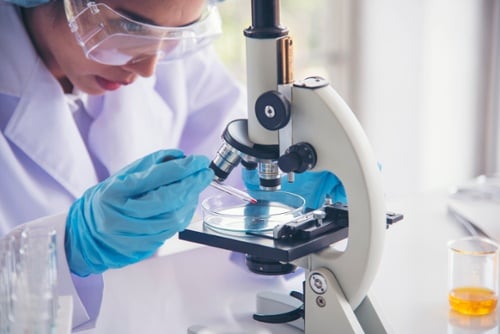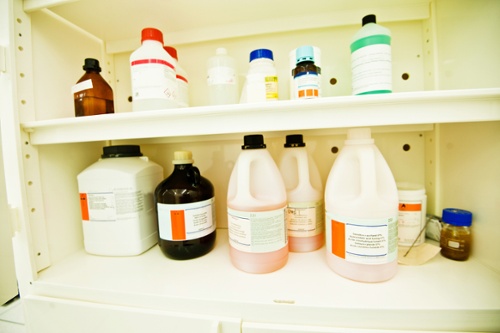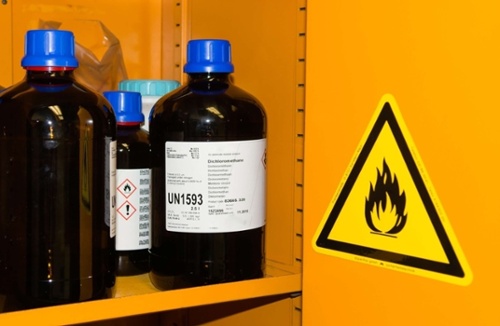One of the most important duties when running a lab is ensuring that your hazardous chemicals and dangerous goods aren’t causing any health or physical hazards. Keeping your staff and community protected from chemical hazards is an ongoing consideration for all laboratories, but it can get a bit complicated when you’re dealing with a multitude of hazardous substances. In this post, we’ll be highlighting some easy ways that laboratory managers can better manage their dangerous goods responsibilities through the implementation of simple daily, weekly and monthly tasks.
Work Health and Safety in Laboratories
Whether you’re running a small medical laboratory or a large commercial facility, your operations need to comply with the WHS laws in your state or territory.

Labs, just like any Australian business, must adhere to the WHS laws of their state or territory.
Ensuring effective dangerous goods management is a key consideration that assists in maintaining a safe working environment.
This process relies on an array of factors, from providing the right instruction and training to your technicians, assistants, students or teachers - to creating effective emergency plans to protect people, place and environment.
While having a good understanding of WHS law is important for ongoing compliance, we highly recommend conducting an onsite risk assessment so you can adequately control your chemical risks. With the complexity of laboratory operations, having a clear understanding of the chemical hazards is crucial for the safety of your workplace.
IMPORTANT: Under WHS law, all employers have a duty of care to themselves, staff (including contractors and volunteers) and other persons in the workplace (such as students or other visitors). The work environment must not pose a risk to health a safety, and facilities should be provided and maintained to ensure the welfare of all personnel.
Controlling Chemical Risk In Labs
There are a varied range of daily, weekly and monthly duties that must be performed in order to maintain chemical safety and compliance in laboratories.

Remember that every chemical product poses a different range of risks, and these must be controlled every day to maintain safety and compliance.
While the scope of these duties is broad, there are several key areas that you can focus on to minimise the likelihood and impact of an incident involving hazardous chemicals.
These include the safety and compliance of:
- Air quality – monitoring and controlling airborne contaminants.
- Chemical segregation – maintaining safe segregation practices for incompatible substances.
- Ventilation – the ongoing inspection and maintenance of all fume cupboards, cabinets and room ventilation systems.
- Workplace ergonomics – the implementation of handling equipment to assist staff in their manual tasks, such as bunded chemical or gas bottle trollies
- Chemical containers – keeping chemicals in suitable containers that remain in good condition.
- Chemical storage – ensuring chemicals are kept in the correct indoor cabinet suitable for the products stored.
- Signage – maintaining the correct chemical container labelling and hazard signage to ensure awareness in staff.
- SDS – keeping each chemical SDS up-to-date and easily accessible for lab staff and emergency workers.
- Register of hazardous chemicals – maintaining your register so all new chemical products are included, and all chemical documents are up-to-date.
- Spill control – utilising adequate bunding products, as well as bunded handling equipment, to prevent uncontrolled spillage.
- Spill response - Having well-maintained, highly visible spill kits installed onsite. Kits should be chemically compatible and suitable for each product you carry. A spill response team should be fully trained in how to conduct the clean-up and disposal of hazardous substances.
REMEMBER: All workplaces that carry hazardous chemicals have a responsibility to meet the requirements of the Work Health and Safety Regulations. While labs present unique challenges in the management of hazardous chemicals, creating a checklist of daily, weekly and monthly tasks can help you maintain a hazard-free working environment.
Developing A List of Regular Duties To Ensure Good DG Management
While the range of risk controls may be broad, the basic duties for lab managers can be broken down into some daily, weekly and monthly duties.
The below lists are a general guide to assist in controlling the risks associated with hazardous chemicals in a laboratory setting. However, depending on the chemicals that you work with and the nature of your work practices, you may adjust your responsibilities to suit the needs of your organisation.
Daily Duties For Lab Managers
- Ensure all staff inspect their gloves and PPE before putting them on; notify the Lab Manager of PPE that requires replacement or repair
- Check containers are labelled correctly according to the relevant legislation
- If opening chemical products, mark the open date on the bottle/container. This is particularly important for peroxidizable chemicalsr
- Wipe over chemical containers before placing back in storage
- Keep chemical storage areas clean and organised
- Keep all air conditioning and ventilation systems working effectively; clean when required
- Make sure that temperature-sensitive chemicals aren’t stored in direct sunlight or near heat
- If flammable or combustible chemicals are onsite, ensure there are no ignition sources brought into the handling or storage area
- Order chemicals while maintaining a minimum stockpile, to reduce the risk of hazards
- Clean up any leaks or spills with the appropriate spill kit
- Ensure that bunds are checked for spillage and these are cleaned out, if required
- The collection of waste, including hazardous chemical waste
IMPORTANT: For detailed information about storing hazardous chemicals in laboratories, you can refer to the Australian Standard. The AS/NZS 2243 series, entitled Safety in Laboratories, covers the key principles of safe storage, including the appropriate equipment, chemical quantities and segregation.
Weekly Duties For Lab Managers
Weekly duties for lab managers may include scheduled inspections of your chemical controls. By maintaining your controls on a regular schedule, your laboratory is adhering to your duties under WHS laws — and ensuring that your controls are working as they should.

Housekeeping is an essential part of maintaining compliance in chemical handling and storage areas.
Some suggested weekly duties may include:
- Inspect chemical bottles, drums, containers etc. for damage, splits or leaks
- Ensure stores are only carrying the correct chemical products
- Check that each product’s SDS is visible and accessible
- Ensure that the hazardous chemicals register is current and correct
- Inspect all chemical storage and handling equipment
- Check that fume cupboards are working effectively
- Inspect all ventilation systems and ensure airborne contaminants are at safe levels
- Inspect the installation and use of chemical storage cabinets
- Clean out all bunds and wiping out all cabinets and shelving
- Check that dangerous goods and hazard signage is in place
- Inspect first aid kits and spill kits
- Ensure there are no incompatibility hazards with other chemicals
- Staff inductions and training, when required
- Order PPE, chemical handling and storage equipment, when required
- Inspect the laboratory for new hazards
- Clean and maintain emergency decontamination equipment
- Report on weekly lab inspections
- Implement any corrective actions, if required
REMEMBER: The Australian Standards define laboratories as any building (or part thereof) which is used, or intended to be used, for scientific or technical work. This includes premises which teach, test, analyse, research or conduct quality control.
Monthly Duties For Ongoing Chemical Safety
Monthly duties for lab managers may include more timely tasks, such as organising risk assessments, reviewing chemical control measures, and ordering chemical storage and handling equipment.

Consider your handling and storage equipment to ensure safety in your lab.
Labs should also ensure all staff training is up to date, with consideration given to changes in chemical inventory or work practices.
Suggestions for monthly duties may include:
- Clean out all old and outdated chemicals
- Monthly lab staff meetings to discuss health and safety issues
- Review of chemical cabinets and other controls to ensure efficacy
- Review of the hazardous chemical ordering for the previous month, with a focus on maintaining a minimum stock level
- Assessment of reported incidents such as spillage, injuries and accidents in the lab
- Further training on chemical safety, if required
- Organise further risk assessments when necessary
- Budget for further chemical containers, handling equipment, storage facilities and PPE
- Inspect all firefighting equipment and emergency decontamination facilities
- Review of chemical inventory and ordering practices
- Review of chemical wastage
- Restocking of all spill kits
- Review of the lab’s emergency plans and responses
IMPORTANT: There are many hazardous substances or dangerous goods which may be used in a laboratory. These may include pathogens or radioactive substances. Your safety and compliance tasks must be tailored to meet the exact needs of your workplace, so the unique risks are controlled and maintained in an organized and methodical manner.
Helpful Resources
In addition to understanding the WHS laws relevant in your state or territory, we strongly suggest familiarising yourself with the Australian Standards.
The Standards offer detailed guidance for each class of dangerous goods, with specific instructions on how to handle and store these substances.
Laboratories can review the Standards that relate to each individual dangerous goods class (such as Standards for flammable and combustible liquids, toxic substances or corrosive substances). It’s also important to review the Standards that are specifically created for laboratories, such as the AS/NZS 2243 Safety in Laboratories series.
Safe Work Australia also offers a comprehensive range of resources to assist all workplaces that carry hazardous chemicals. Some helpful codes of practice include:
- Preparation of safety data sheets for hazardous chemicals
- Managing risks of hazardous chemicals in the workplace

Lab managers can access a range of online resources to assist with your management of dangerous goods.
Chemical Safety In Laboratories
As we’ve highlighted in this post, chemical compliance and safety is more easily achievable when taking a clear, straightforward, and systematic approach. Dividing tasks into daily, weekly and monthly duties will help all laboratory staff maintain a safer working environment, through the process of inspections, maintenance and corrective actions.
To learn more about working with hazardous substances, you can access our free eBook. Our easy-to-read guide will introduce you to our 4-step risk control methodology, which can be applied to any workplace, including chemical laboratories. Grab your copy today by simply clicking on the image below.
Joining the team as a Dangerous Goods Storage Consultant, Melissa Hampton became Storemasta's Marketing Manager in late 2021. With extensive knowledge and experience in chemical compliance, Melissa is responsible for leading the Marketing team and helping shape their marketing strategy. In her spare time, you can find Melissa hiking, swimming and enjoying the great outdoors in beautiful north-west Tasmania.
